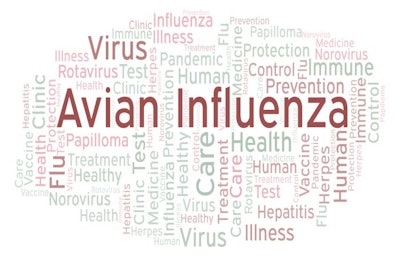
Over the past week, Russia’s agriculture ministry has confirmed the presence of highly pathogenic avian influenza (HPAI) of the H5 group in the North Caucasian federal district. According to the official report to the World Organisation for Animal Health (OIE), this is the first occurrence of this infection in the region.
Affected by this outbreak is a flock of more than 170,000 poultry in the Republic of Karachay-Cherkassia. More than 19,000 of the birds died at the affected farm.
As well as being the first occurrence of HPAI in this region, this latest outbreak is a significant development in the spread of the virus in Russia this year. It brings to four the number of federal districts where HPAI has been detected in poultry since mid-August. In an apparent east-to-west spread of the disease, previous outbreaks have been confirmed firstly in the Siberian, then the Urals, and most recently in the Volga federal district.
Further east in the Urals federal district, there have been four new outbreaks of HPAI linked to the H5N8 virus subtype. Affecting a total of almost 700 poultry, all the flocks were described as “backyard,” varying in size from 35 to 540 birds. According to the agriculture ministry’s report to the OIE, the outbreaks were in different districts of Kurgan oblast.
Since the second week of August, Russia has confirmed to the OIE a total of 47 HPAI outbreaks in poultry. Based on the official reports, more than 1.743 million poultry have been directly affected in the outbreaks. In each case, restrictions have been put in place around infected premises. Furthermore, the agriculture ministry continues to state that products from the outbreak premises have never been commercially traded.
Officials in Kazakhstan have implicated Russia as the source of its on-going outbreaks. As Karachay-Cherkassia borders Georgia, further international spread of the infection looks likely in the coming months.
After an absence of more than two years, HPAI has also returned to the Russian wild bird population. Since the end of August, 10 ducks and swans found dead in Siberia and the Urals have tested positive for the H5N8 HPAI virus variant.
Another Kazakh village in avian flu lockdown
After HPAI cases were identified in poultry last week, another village in Kazakhstan has been placed in quarantine for three weeks. According to Radio Free Europe, the affected village is in the south of Zhambyl. Located in the south of the country, this region borders Kyrgyzstan. It is the country’s seventh region to record cases of HPAI.
Local officials report that 60,000 domestic poultry have been vaccinated against avian flu “since hundreds of chickens, geese, and ducks died” earlier this month. No cases have been recorded in the human population. However, the virus has also been detected in poultry in the regions of Akmola, Kostanay, Pavlodar, Karagandy, and Turkistan, according to this source. The latter shares an international frontier with Uzbekistan.
Around the middle of September, the first cases in Kazakhstan were reported near to the northern border with Russia, in the region of North Kazakhstan.
Taiwan detects one new case of HPAI
Suspicious signs at post mortem alerted authorities in Taiwan to a possible new cases of HPAI in a native chicken earlier this month. The bird tested positive for the H5N5 virus subtype, and was destroyed, according to the official report to the OIE.
The Council of Agriculture reported that other carcasses were destroyed at the slaughterhouse in New Taipei City, and that the premises were cleaned and disinfected. The source of the birds is being traced.
These were the first cases of HPAI in the city this year, and it brings to 48 the total number of outbreaks linked to this virus over the past year.
Avian flu restrictions eased in Australia’s Victoria state
Across much of Golden Plains Shire, the order for all poultry to be housed has lapsed, according to Agriculture Victoria, the state’s agriculture authority. Flock owners in the former control area no longer need to keep their poultry housed. However, those in the restricted area must continue to contain their birds until at least October 19.
Housing orders were put in place temporarily to minimize the risk of poultry and captive birds becoming infected with avian flu through contact with wild species.
This move followed confirmation of avian flu at a total of six farms across the state of Victoria, starting on July 24. These included four premises near Lethbridge (Golden Plains Shire), one near Bairnsdale (East Gippsland), and one emu farm near Kerang (Gannawarra). HPAI of the H7N7 subtype affected three farms with laying hens. Furthermore, low-pathogenic avian influenza (LPAI) virus of the H5N2 variant was detected at two turkey farms, while an H7N6 virus was found in the emu flock.
View our continuing coverage of the global avian influenza situation.
















